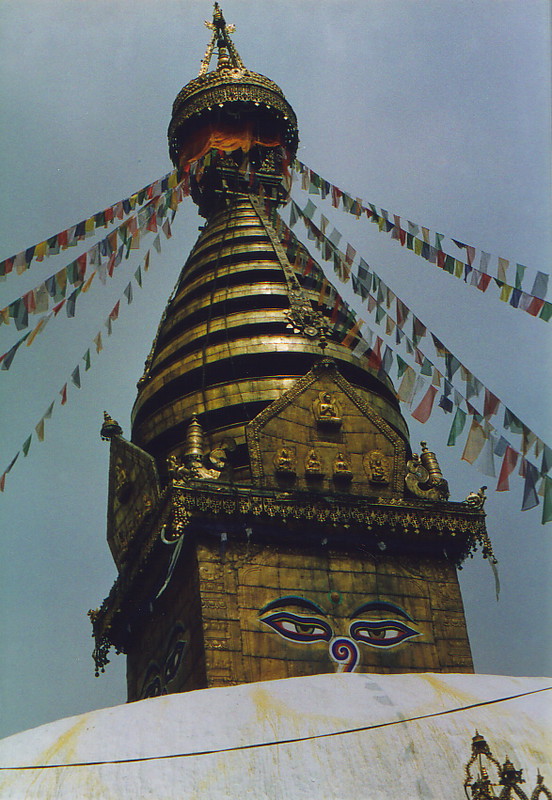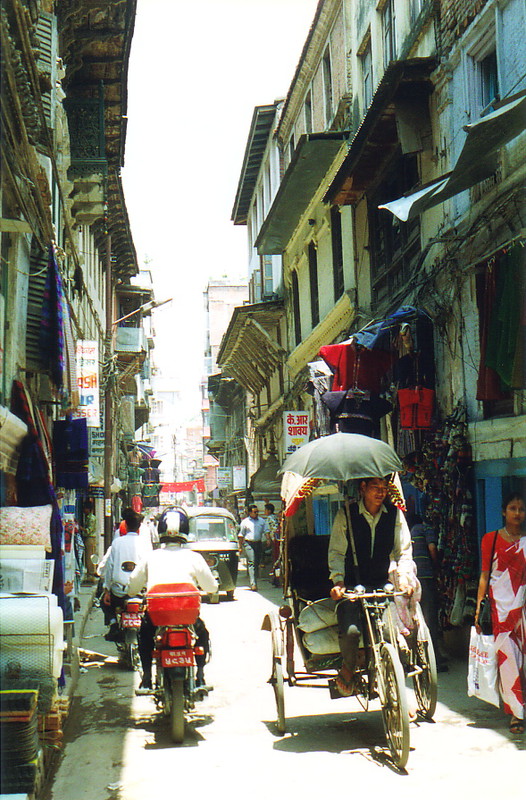
A lone white man ambles through the square, looking lost in the way that only tourists can manage. Durbar Square is bustling, but in his mission to take in the atmosphere he's committed the ultimate sin and the touts aren't going to miss a trick. 'Rickshaw, mate, cheap price'; 'Picture? One picture?'; 'Something to smoke...?'; 'Money change, you make money change?'; 'I am very good guide, sir, many things to see in Durbar Square'; 'Just looking, sir, just looking, very good stones'. In Kathmandu, you learn to look occupied all the time if you want to avoid hassle, and he'll learn quickly enough.
Kathmandu's Durbar Square is a strange collision of worship and wheeler dealing. The pagodas on the scores of temples in the city's cultural centre provide steps for people to loiter on, trading gossip and hatching deals and schemes. For the rickshaw-wallahs it's a place to catch trade, and for the street sellers it's a Covent Garden without licences or regulations; and as if the mayhem caused by milling crowds and street vendors isn't enough, it's also a busy thoroughfare for taxis, bicycles, motorcycles and porters with their huge baskets of goods, bound for some other dusty corner of the city. If Kathmandu has a heart then it's here, the source of pulsating arteries that speed off1 in all four directions of the compass.

My hotel was just round the corner from Durbar Square, which feels a million cultural miles away from the suburb of Thamel, even though it's only a 15-minute walk. Thamel is to Kathmandu what Khao San is to Bangkok, what Kuta is to Bali, and what Goa is to Nepal: it's the country's centre for travellers. Unfortunately, with this territory comes the usual collection of restaurants, travel agencies, craft shops, email centres, touts, marijuana pedlars, good pizza and, rather disappointingly, an almost complete lack of character. I had anticipated a soul-free environment, but Thamel has all the charm of a McDonald's; so I popped in, did what I had to do, and moved on as quickly as I could.
The Monkey Temple

Luckily the rest of the city has plenty of charm, even through the misty haze of a strange apathy that struck me as I explored. Swayambhunath Temple, colloquially known as the Monkey Temple due to its local residents, is a pleasant but not terribly surprising Nepalese temple – Buddhist stupas, Hindu shikharas and pigeons galore – but its unearthly combination of Hinduism and hawking makes it worth a visit. Besides, western tourists are such funny creature sometimes, with their inappropriate clothes, in-your-face photography and a total lack of bargaining ability, that I found watching the watchers much more interesting than yet another collection of gunk-smeared statues of the Hindu-Buddhist pantheon.
Especially interesting, though, was one particular western woman, who must have been in her mid-thirties; complete with tika marks on her forehead from a recent puja, she was leaning on the grate containing a statue of Locana, the consort of Aksobhya, one of the Dhyani buddhas who sits in the pose of subduing Mara, or resisting the temptation of the devil. Through her mumblings, I saw a look on her face that I recognised; it was the look on a child's face when snuggling up to its mother, a blissful awareness of warmth and security.

I get that look when a particularly good Led Zeppelin riff hits the speakers, but she was getting it from a religion; this was wonderful for her, and as I watched her distant smile and lightly closed eyes, I wondered if I was missing out on something magical... but then the grungy guitar line from Whole Lotta Love started grinding through my subconscious, and I realised that I've got it all right here, in my head. Music is my portable religion and CDs are my icons, blasphemous though that may sound.
What a shame, though, that Kathmandu was perpetually shrouded in the pre-monsoon mist, clouding out the mountains and making the potentially spectacular views from the temples more reminiscent of Calcutta from the Howrah Bridge. People complain bitterly about Kathmandu's pollution, and although it feels like a paragon of cleanliness after India, it's still got a long way to go as far as air pollution goes; the face mask is as common here as it is in Bangkok.
The Suburbs

One day I walked south of Kathmandu to Patan, previously a separate city state but now effectively a suburb of the capital; the third city in the Kathmandu Valley, Bhaktapur, is a little further to the east, and was again a separate state with a separate king before the three cities were finally united in 1382 by the rulers of Kathmandu (which is why Kathmandu is the capital and not Patan or Bhaktapur). Patan has as its main attraction a huge number of temples, and it was here that I realised that I'm templed out and am finding it hard to give a hoot about the things. Imagine doing a tour of Europe where the main attraction was churches; after a couple of months you'd probably break into a cold sweat at the sight of yet another spire. For me, anything to do with Buddha, Siva, Krishna, Vishnu and the rest of the gang is, by now, just another building.

The walk back from Patan had its surprises, though. For example, the fields of marijuana plants lining the River Bagmati are a sight to behold; one minute you're wandering along the path minding your own business, and the next minute you're surrounded by luscious greenery, reaching well above head height and generating a distinctive smell on the breeze. I had to stop to take a picture, it was such a sight, and in the process I managed to attract the attention of one of Kathmandu's more sociable wasters. After the inevitable small talk he gestured to the buds swaying in the breeze and asked, 'Do you know what this is?'
'It's marijuana,' I replied. 'And I thought Calcutta was the City of Joy.'
'It's grass,' he said, sniffing at my terminology with a smile in his eye. 'Grass,' he repeated, and turned to go; he didn't even look back or say goodbye. Perhaps announcing that this was grass was his party piece and he'd done his bit, or perhaps he'd enjoyed the local crop just a little too much to hold a conversation longer than two minutes. I didn't mind a bit; some conversations are dead in the water before they're launched.

So I returned to Kathmandu, studiously walking straight past the millions of holy sites and instead marvelling at the insanity of the locals. For example, I went to an electrical shop to buy a bulb for my torch which had blown right in the middle of the previous night's power cut; the man didn't have the right type, and answered my ensuing question by saying that there were no other shops around who sold bulbs, and none that sold torches. He obviously didn't get out much; four doors down was a man with bulbs and torches who sold me what I wanted without hesitation.
The next local I encountered shouted over to me, 'Where you from? Australia?' Now this was getting strange, as this was the third time that I'd been called an Australian that day, and I hadn't even opened my mouth or put on my bush hat, so I walked over and asked him why he thought I was an Aussie. 'You've got a beard,' he replied, as if that was all the explanation anyone needed. It scuppered me completely, enough to motivate me to book a ticket for my next destination, Janakpur.
1 OK, this is poetic licence, I admit. You're just as likely to find a speeding car in Kathmandu as you are on the M25 at 5.30 on a Friday afternoon, but what the Nepalese lack in velocity they make up for with voracity, and what their rusty old cars lack in aesthetics they make up for with acoustics. As long as the accelerator's connected and the horn works, the car is fine.